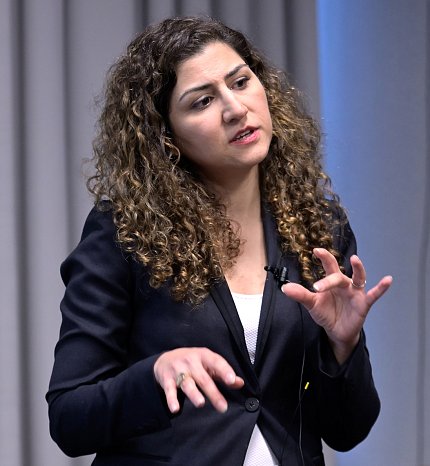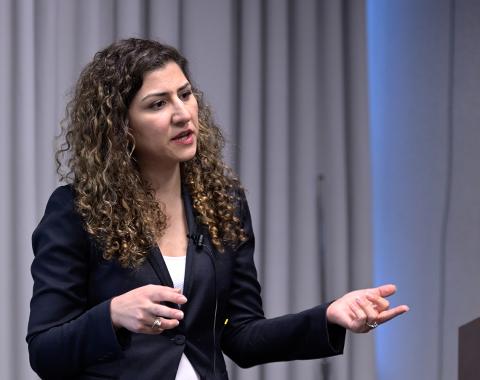New Neurotechnologies
Shanechi Explores How to Decode Mood

Photo: Marleen Van Den Neste
Sometimes it seems almost unpredictable. Our mood is often affected by many conditions and variables. Could it really be possible to predict and control our mental state?
Such a prospect could bring relief to the many who suffer from neuropsychiatric disorders, including the millions of people in the United States who have treatment-resistant major depression.
Dr. Maryam Shanechi is pioneering work to model and decode mood variations, efforts that ultimately could enable modulating brain networks to treat neuropsychiatric disorders. Shanechi, whose honors include the MIT Technology Review’s top 35 innovators under age 35, is an assistant professor of electrical engineering and neuroscience at the University of Southern California and director of USC’s Neural Systems Engineering Lab. She spoke at a recent NIMH Director’s Innovation Speaker Series lecture in the Neuroscience Center.
One type of brain-machine interface (BMI) that Shanechi’s lab works on allows the brain to manipulate devices, such as motor-neural prosthetics for paralyzed patients.
“We also spend a significant amount of time developing a new generation of BMIs that aim to do the opposite,” said Shanechi. “So instead of allowing the brain to control an external device, you now want to control the state of the brain itself to treat neuropsychiatric disorders, for example, using electrical stimulation.”
For some patients, stimulating a certain brain region can alleviate depression symptoms. Some patients, however, don’t respond to this open-loop electrical stimulation. Shanechi’s team instead focuses on closed-loop stimulation, to adjust stimulation in real time based on decoding a mood state.
“We guide and stimulate the brain with the very activity we’re trying to modulate and control,” she said, “basically closing the loop.”
This has never been done before, at least not for psychiatric disorders. Closed-loop stimulation has been successfully applied to neurological conditions such as Parkinson’s disease by identifying a biomarker, and then turning stimulation on and off depending on whether the biomarker is above or below a threshold.
But mental states are largely distributed across networks, not at single sites. So a local biomarker may not work in this case. Instead, targeting mood would require decoding it by aggregating information across the network. Shanechi set out to build a dynamic model to track mood variabilities and guide how to modulate stimulation in real time within a feedback controller.

Photo: Marleen Van Den Neste
“Even if we know someone’s mood perfectly, we still wouldn’t know how to change it toward the therapeutic target level,” said Shanechi. A neural decoder would monitor changing mood, though researchers would also need to design a feedback controller to guide the stimulation parameters toward desired levels.
Recent work with epilepsy patients showed investigators that they could decode mood variations in human subjects. Shanechi collaborated with Dr. Edward Chang, a neurosurgeon at UCSF, to obtain brain and mood data from these patients. While the patients were in the hospital getting monitored for seizures across multiple brain regions, they intermittently completed electronic mood questionnaires while hooked up to an electrocorticography (ECoG) machine. This gave Shanechi’s team a data set to then start identifying specific network sites to decode and model.
With the algorithms they built for each network, Shanechi tested her model from the brain recordings of 7 people.
“In every single individual, we could significantly decode their mood variations, therefore opening the possibility of personalized therapies for mood disorders,” she said.
Their decoder largely recruited the brain’s limbic regions, said Shanechi, which was consistent with other studies showing the significance of these regions on emotion. As the decoders scanned patients’ brains, the most recurring region was the orbitofrontal cortex.
But decoding is not enough for closing the loop, which also requires knowing how to change the stimulation for a desired outcome. Thus, Shanechi currently is building a data-driven modeling framework for this network that can predict how stimulation changes neural activity and thus the mood symptoms. To get informative data for fitting these models, “you want to stimulate the brain in a way that excites it across all frequency bands,” she said. “Therefore, you want some sort of white-spectrum input, just like white noise.”
She designed clinically safe white-spectrum waveforms that start with pulses, then allow for stochastic changes in amplitude and frequency to mimic white noise. Testing has already begun with encouraging results for accurately predicting how neural activity changes in response to changing stimulation. The next step is building closed-loop controllers and testing them in people. Shanechi is also working to develop multiscale models of brain network activity.
“We know that behavior involves not only small-scale neural processes measured with spiking activity of neurons,” she said, “but also larger-scale integrated neural processes measured with field potentials.”
The modeling challenge here is that the signals have fundamentally different characteristics. Large-scale field potentials such as ECoG are continuous with slower time scales, she explained, while small-scale spikes are binary-valued with fast millisecond timescales. The new models must describe all these signals together and account for their different characteristics.
Shanechi’s lab has built a multiscale decoder that can combine information from spike-field signals at different timescales to improve accuracy and an algorithm to extract behaviorally relevant dynamics from these signals. The new algorithms are all extendable to mental states and adaptable to closed-loop control.
Shanechi continues to test these models while developing new ones, with the ultimate goal of helping us better understand dynamics across the brain that would lead to new neurotechnologies and other therapies to treat psychiatric disorders.
